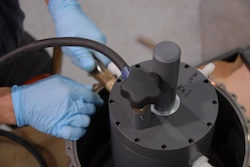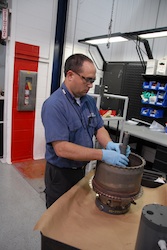Award Winning Modernization of Metal Electroplating Technology Could Save DoD Millions
“Less is more,” said the poet. Although Robert Browning was referring to a Renaissance artist, the same sentiment applies to the more mundane but venerable process of electroplating. And paying attention to this adage helped a team led by the National Center for Manufacturing Science (NCMS) solve a long-standing problem and win an award in the bargain.
Thousands of metal parts go to make up vehicles, aircraft, and machinery, some moving, some stationary, but all exposed to the forces of corrosion and wear.
Electroplating is a process in which an electric field moves metal ions in a solution to coat an electrode. The idea is to coat a conductive object with a thin layer of material, like a metal, to give it a desired property such as corrosion protection or wear resistance – a process that is essential to making exposed parts perform better and last longer.
The basic techniques involved in electroplating have not changed substantially in over 100 years. You carefully hand masks areas of the part you wish to protect from plating, and dip the whole thing into an electrified tank for several hours.
This process is time consuming – masking takes hours and, to make matters worse, it is highly error prone. It is also inefficient: as much as 90 percent of the required electrical power is wasted; and dangerous: plating baths are highly toxic.
Seeking a Solution
 NCMS led a collaborative team of industry and Department of Defense (DoD) participants that tackled an innovative Commercial Technologies for Maintenance Activities (CTMA) project that sought to address all these issues with a single, powerful solution. The idea was to eliminate masking labor, achieve faster plating times, improve uniformity of deposits, and minimize the hazards involved.
NCMS led a collaborative team of industry and Department of Defense (DoD) participants that tackled an innovative Commercial Technologies for Maintenance Activities (CTMA) project that sought to address all these issues with a single, powerful solution. The idea was to eliminate masking labor, achieve faster plating times, improve uniformity of deposits, and minimize the hazards involved.
The team consisted of depot engineers at Corpus Christi Army Depot (CCAD) and the Fleet Readiness Center (FRC) Southwest, as well as Advanced Tooling Corporation (ATC). Together they developed tooling to eliminate the masking step altogether (no-mask anodes in the jargon of the trade), an impressive achievement with amazing results.
Each no-mask conforming anode is custom-made to the part it will plate. An acid-resistant PVC fits tightly around the part. The tooling incorporates an anode configured to the specific part shape, which improves the speed and uniformity of the metal deposit by ensuring optimal anode placement for each part, regardless of geometry. Those areas to be plated are exposed to the solution and anode – the rest of the part does not electrically interact with the plating process.
An additional benefit is that no-mask anodes are designed to minimize hydrogen bubbling; they can even be operated outside a plating tank, with plating fluid pumped through the tool at high speed.
Pilot tests produced some truly astonishing statistics. They included a 95 percent reduction in pre-plating part preparation, a 45 percent reduction in plating time, a 50 percent increase in plating tank capacity and $2,220,000 in immediate annual savings from the pilot parts alone.
If deployed across the DoD, in only three years the new technology could generate several million dollars in savings, with an overall process time improvement of 35 to 50 percent.
The technique is also a boon to the environment. No-mask conforming anodes are fully reusable. The technology completely eliminates the mountains of tape, wax, and other maskants used in the older process. This detritus must be disposed of as hazardous waste – even brief exposure to these toxins can lead to serious health complications.
 A Winner
A Winner
Last November this groundbreaking project caught the eye of both government and industry at SAE’s 2011 DoD Maintenance Symposium and Exhibition in Fort Worth, Texas when it won the prestigious “Great Ideas Competition.”
The annual symposium brings together thousands of government and industry representatives to exchange ideas to improve maintenance practices and procedures aligning with CTMA’s mission to ensure American troops and their equipment are ready to face any situation, with the most up-to-date and best maintained platforms and tools on earth.
No-mask anodes fit right in with the CTMA charter, not to mention the old observation that less is indeed more.
Watch the NCMS video for more on the no-mask process.










